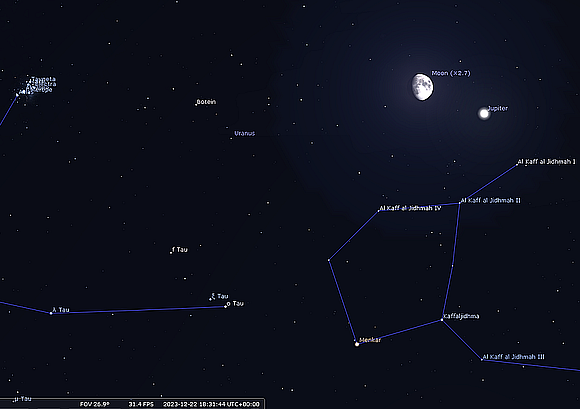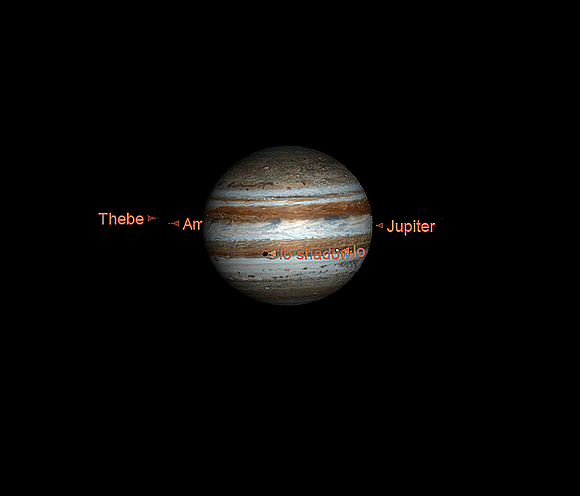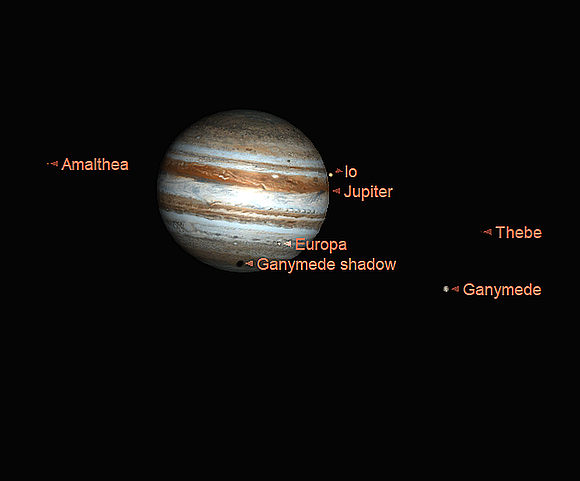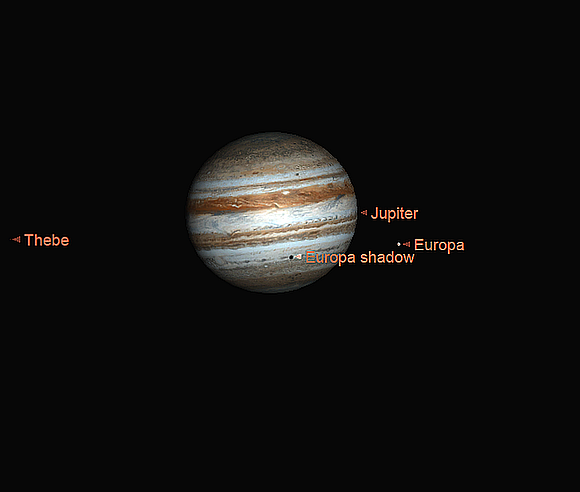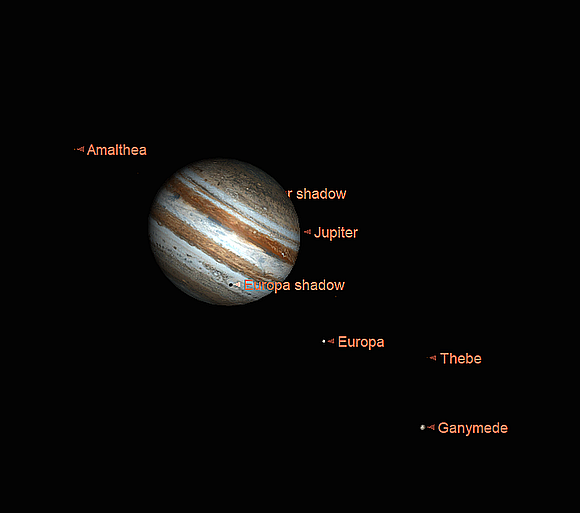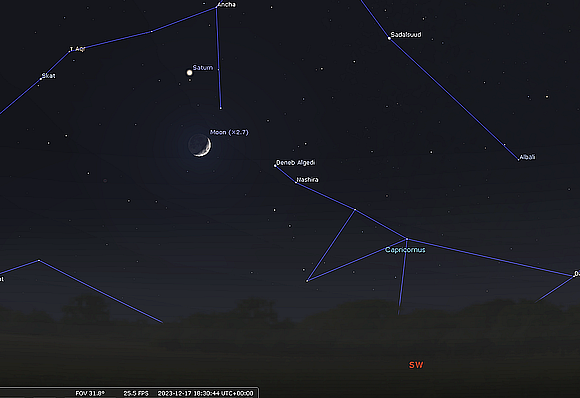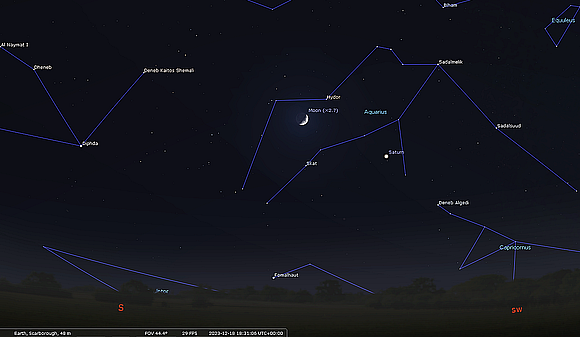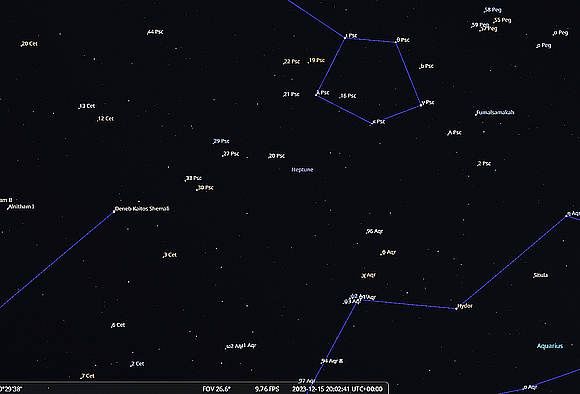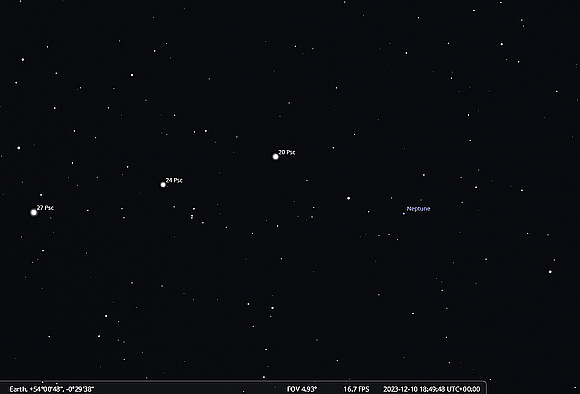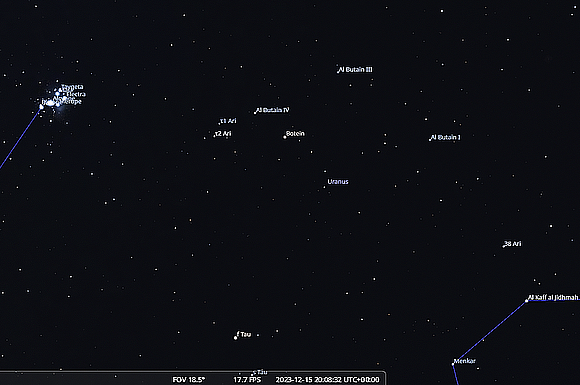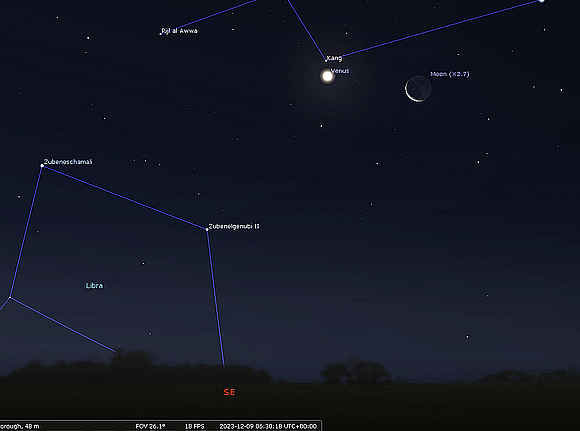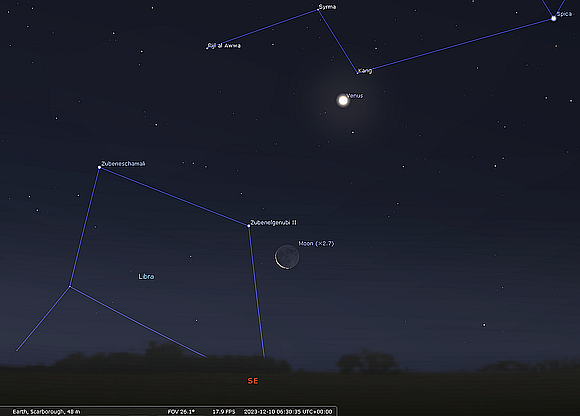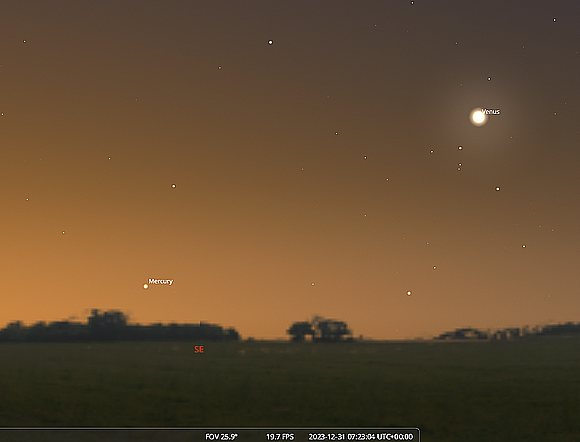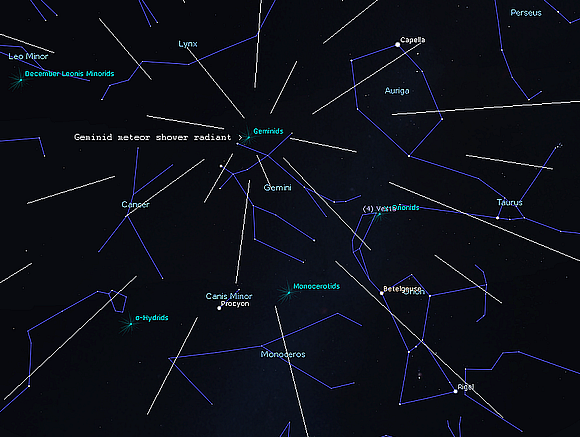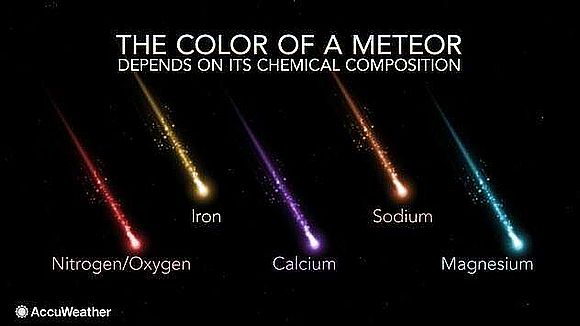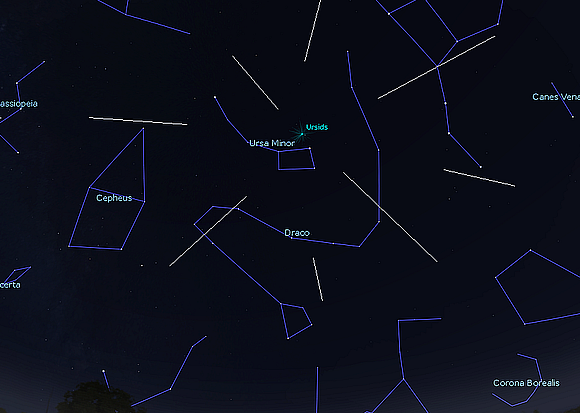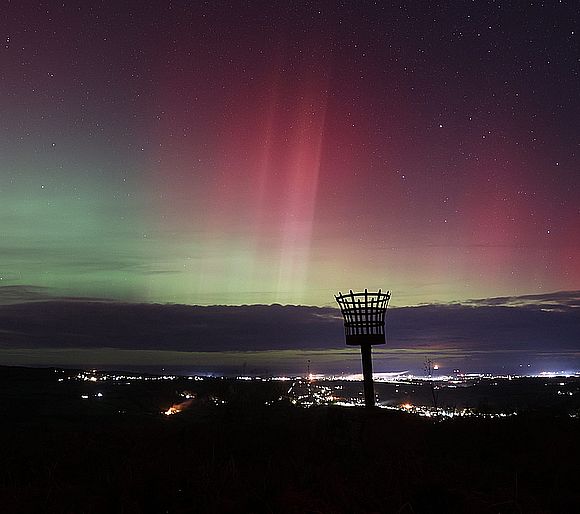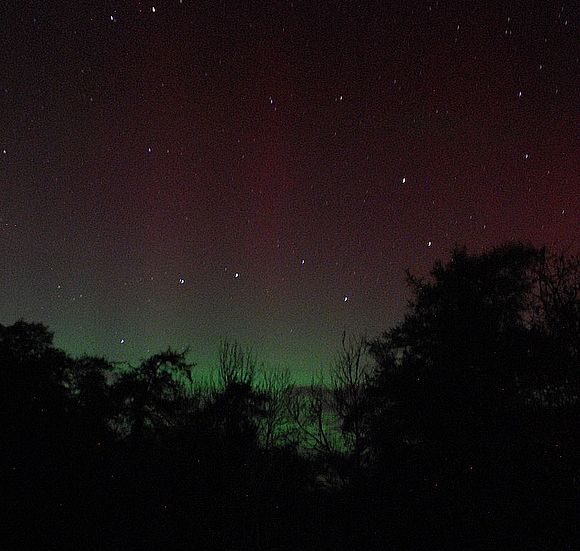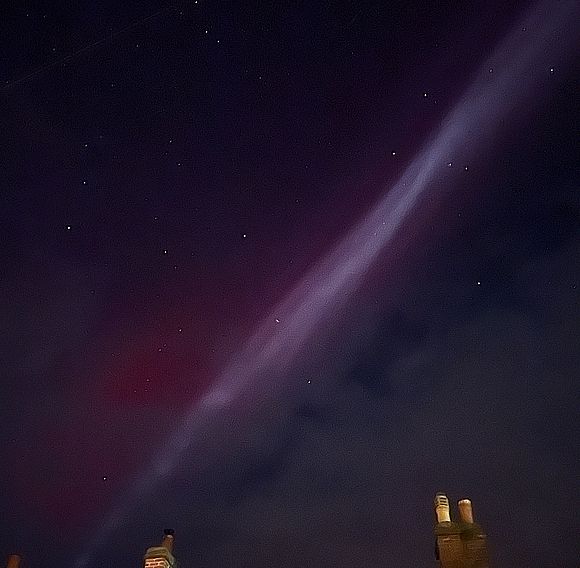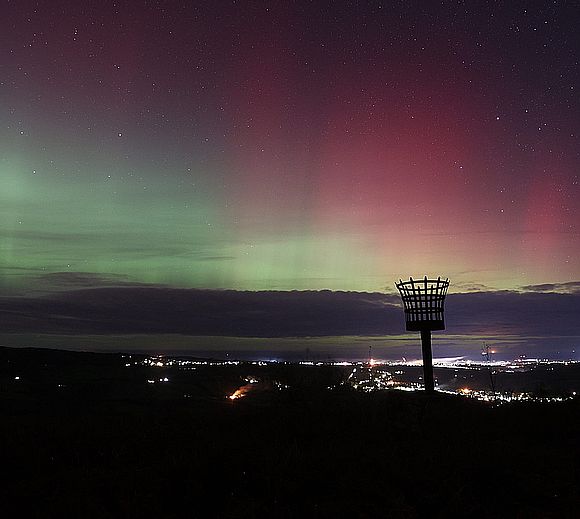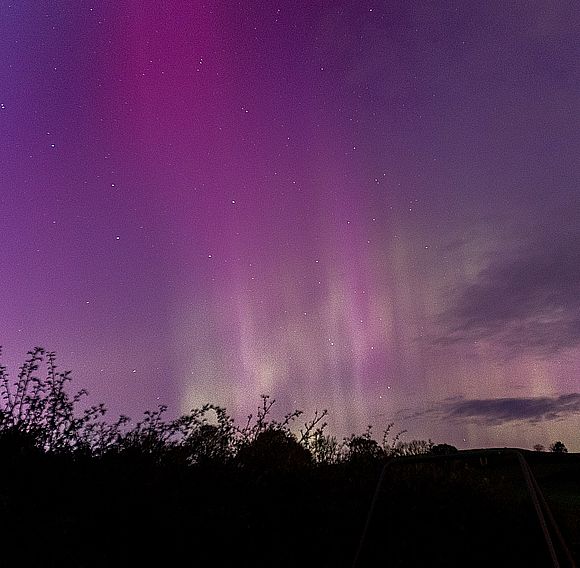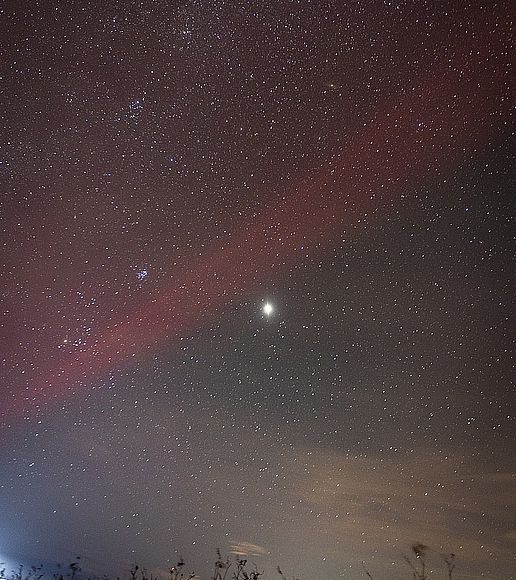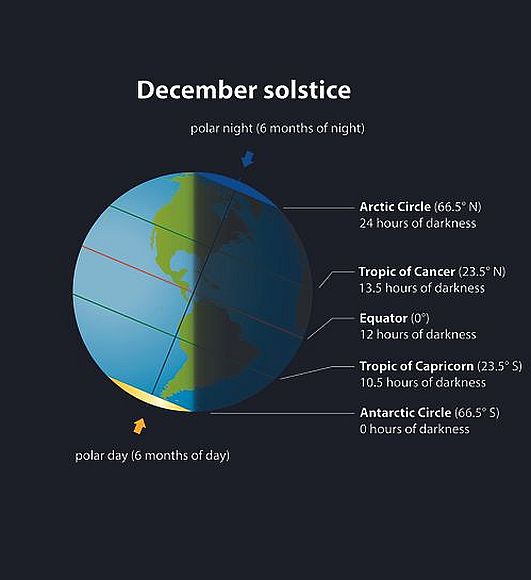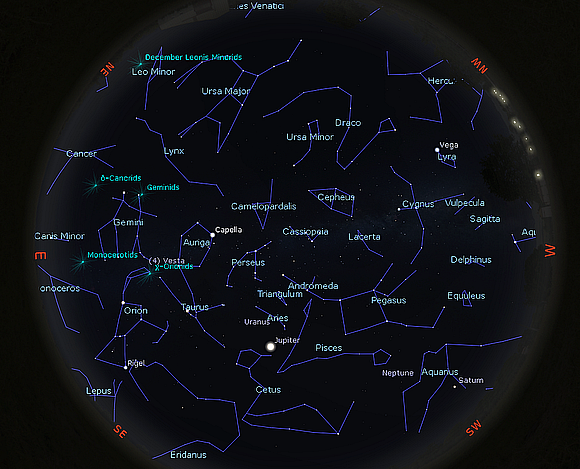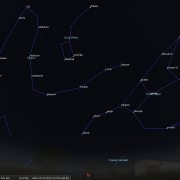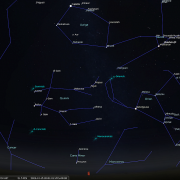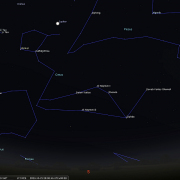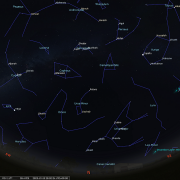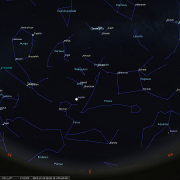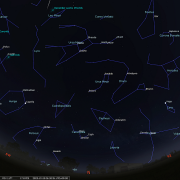In this month's Sky Notes:
- Planetary Skylights
- December Meteor + Aurora Sightings
- Winter Solstice
- December Night Sky
- December 2023 Sky Charts
Planetary Skylights: A Brief Guide to December's Night Sky
Jupiter dominates the night sky. Saturn is well placed in the evening sky, as are Neptune and Uranus, but these will require a telescope to identify. Venus still rules the dawn sky. Mercury has an extremely poor evening apparition before commencing a reasonable morning one in the dying days of December.
 At magnitude -2.8 Jupiter still rules the planetary roost in the night sky (until Venus rises in the early morning hours). Having reached opposition early last month, Jupiter is well placed for evening observation during December residing in the southern reaches of Aries - near the border with Cetus. Jupiter culminates some 50 degrees above the S horizon, not dropping back below 30 degrees until the early morning hours therefore affording UK observers a useable seven hours viewing window. Jupiter is in retrograde motion, moving east to west just above the loop of faint stars marking the head of Cetus.
At magnitude -2.8 Jupiter still rules the planetary roost in the night sky (until Venus rises in the early morning hours). Having reached opposition early last month, Jupiter is well placed for evening observation during December residing in the southern reaches of Aries - near the border with Cetus. Jupiter culminates some 50 degrees above the S horizon, not dropping back below 30 degrees until the early morning hours therefore affording UK observers a useable seven hours viewing window. Jupiter is in retrograde motion, moving east to west just above the loop of faint stars marking the head of Cetus.
Through the eyepiece Jupiter exhibits an oblate disk some 46 arc seconds in diameter flanked by the Galilean moons - visible as bright specks of light. The dark equatorial belts will be readily visible in instruments as small as 60mm (2.5”) aperture, with the less evident polar regions apparent in 75mm instruments. Mounted binoculars in the range of 12 x 50 and 15 X 70 should also reveal these features. Larger instruments will show the finer northern and southern temperate belts. When turned in our direction look for the great red spot feature, (appearing paler and smaller than 20 years ago). The GRS can be observed in 100mm (4”) scopes but will be more obvious with 150mm (6”) instruments at medium powers. Look for the GRS on the 3rd, 5th, 10th, 15th, 17th, 22nd, 27th, and 29th from 18:00 - 20:00hrs GMT.
The Galilean moons, Jupiter's four large satellites are fascinating to follow. The configuration of these constantly changes as they orbit around Jupiter. Look for following favourable Galilean moon shadow transits (visible as black dots transiting the disk of Jupiter) on the following dates, Ganymede - Dec 23rd around 19:00hrs, Europa - Dec 16th and 23rd @ 18:00hrs and 21:00hrs GMT respectively, and Io – Dec 1st and 24th @ 18:00hrs GMT. The waxing first quarter Moon lies is in the vicinity of Jupiter on Dec 22nd.
 Saturn continues to be a viable object throughout December evenings in the S/SE, although by the end of the month it is setting before 20:00hrs from the UK. At magnitude +0.8, Saturn is reasonably conspicuous amongst the faint stars of southern Aquarius - a region of the sky rather lacking in naked eye stars. At the start of December Saturn culminates a respectable 20 - 23 degrees above the S horizon from the UK, but still 11 degrees below the celestial equator. It will continue to gain in declination over the coming decade, crossing into the northern half of the sky by 2026.
Saturn continues to be a viable object throughout December evenings in the S/SE, although by the end of the month it is setting before 20:00hrs from the UK. At magnitude +0.8, Saturn is reasonably conspicuous amongst the faint stars of southern Aquarius - a region of the sky rather lacking in naked eye stars. At the start of December Saturn culminates a respectable 20 - 23 degrees above the S horizon from the UK, but still 11 degrees below the celestial equator. It will continue to gain in declination over the coming decade, crossing into the northern half of the sky by 2026.
Given the right conditions, Saturn is a glorious spectacle through the eyepiece, the rings are however tilted by just 9 degrees, the orientation slowly closing for the next ring plane crossing event in 2025. Observation of the two major rings (ring A and B) is therefore rather more challenging for smaller instruments under 150mm (5"), the gap between them; the Cassini division, discernible in larger instruments 200mm (8") plus. Saturn's largest moon, Titan, is visible as a speck of light in nearly all instruments. On December 17th a crescent Moon resides below Saturn and upper left a day later.
 Faint Neptune remains on show for telescopic observation throughout December evenings. The outermost planet resides approximately 15 degrees east of Saturn, below the faint loop of stars marking the western fish of Pisces - in particular lambda Piscium (mag 4.5). The nearest 'bright' star is 5th magnitude 20 Piscium 30 arcminutes to the right of Neptune. Neptune itself is at magnitude +7.9 appearing as a minute 2.4 arc-second disk through the eyepiece, although bear in mind Neptune is very remote, over 4.3 billion Km (2.67 billion miles) or 28.9 AU distant.
Faint Neptune remains on show for telescopic observation throughout December evenings. The outermost planet resides approximately 15 degrees east of Saturn, below the faint loop of stars marking the western fish of Pisces - in particular lambda Piscium (mag 4.5). The nearest 'bright' star is 5th magnitude 20 Piscium 30 arcminutes to the right of Neptune. Neptune itself is at magnitude +7.9 appearing as a minute 2.4 arc-second disk through the eyepiece, although bear in mind Neptune is very remote, over 4.3 billion Km (2.67 billion miles) or 28.9 AU distant.
Unless 'seeing' is steady the disk is not obvious, an aperture of 150mm (6”) and medium/high magnification is required to clearly define it. Neptune can be spotted as a speck in 10x50 binoculars (if you know exactly where to look). Avoid trying to track down when the Moon is in the vicinity.
 Uranus is well placed for observation located roughly between Jupiter and the Pleiades star cluster. With a magnitude of +5.8 Uranus is technically visible to the naked eye, however very dark skies and good sky knowledge of its exact location are required to achieve this. An aperture of 75-80mm (3") will hint at the tiny 3.5-degree disk, soft green/grey in hue, whilst instruments above 150mm (6") will clearly reveal it using medium/high power. Uranus is currently in Aries, not far above the 'head' of Cetus, but is close to the Taurus/Aries border. Culminating late evening 50 degrees above the south horizon, Uranus is a viable observing object until 04:00hrs GMT. Delta Ari sits just over 2 degrees above Uranus, also nearby are 53 and 54 Ari with which it forms an isosceles triangle. The Moon sits 3.5 degrees upper left of Uranus on Dec 23rd.
Uranus is well placed for observation located roughly between Jupiter and the Pleiades star cluster. With a magnitude of +5.8 Uranus is technically visible to the naked eye, however very dark skies and good sky knowledge of its exact location are required to achieve this. An aperture of 75-80mm (3") will hint at the tiny 3.5-degree disk, soft green/grey in hue, whilst instruments above 150mm (6") will clearly reveal it using medium/high power. Uranus is currently in Aries, not far above the 'head' of Cetus, but is close to the Taurus/Aries border. Culminating late evening 50 degrees above the south horizon, Uranus is a viable observing object until 04:00hrs GMT. Delta Ari sits just over 2 degrees above Uranus, also nearby are 53 and 54 Ari with which it forms an isosceles triangle. The Moon sits 3.5 degrees upper left of Uranus on Dec 23rd.
 Venus continues to be a brilliant presence in the dawn sky rising in the east by 03:30hrs GMT as December commences. At magnitude - 4.2 Venus certainly attracts the eye of early risers, climbing above 30 degrees in elevation by 06:00hrs. Venus can appear over dazzling through the eyepiece, so, if possible, wait until skies begin to lighten a little to better discern the phase - a waxing quarter. A slim waning crescent Moon lies in proximity to Venus on Dec 9th and 10th.
Venus continues to be a brilliant presence in the dawn sky rising in the east by 03:30hrs GMT as December commences. At magnitude - 4.2 Venus certainly attracts the eye of early risers, climbing above 30 degrees in elevation by 06:00hrs. Venus can appear over dazzling through the eyepiece, so, if possible, wait until skies begin to lighten a little to better discern the phase - a waxing quarter. A slim waning crescent Moon lies in proximity to Venus on Dec 9th and 10th.
 Mercury undergoes a very poor evening apparition over the Christmas period, before swiftly moving into the morning sky for the last few days of December, commencing a more favourable showing early in the New Year. Try your luck on the very last morning of the year - around 07:20hrs scouring a few degrees above the SE horizon. Venus will lie a couple of hand spans upper right.
Mercury undergoes a very poor evening apparition over the Christmas period, before swiftly moving into the morning sky for the last few days of December, commencing a more favourable showing early in the New Year. Try your luck on the very last morning of the year - around 07:20hrs scouring a few degrees above the SE horizon. Venus will lie a couple of hand spans upper right.
December Meteors
Meteor activity reaches a peak at this time of year with two major meteor showers occurring within the space of 20 days and a lesser shower sandwiched in between. Given any clear skies over this period the chances of spotting more than a few shooting stars are therefore high! First up are the Geminids, considered to be the most prolific and reliable annual meteor shower. The Geminids are active from December 7-16, reaching a peak this year in the early morning hours of December 14th.
Geminid debris stems from a small asteroid called Phaethon which may even be the nucleus of a ‘dead’ comet. At a perihelion passage, Phaethon passes within ten million miles of the Sun causing the object to deposit material over great swathes of the inner solar system. It is only within the second half of the 20th century that Geminid activity has increased to the levels now recorded, a result of Earth passing through a denser debris strand, a situation that will continue only for another hundred years or so.
The shower radiant lies close to Castor, in Gemini, visible in the east by 18:00hrs. Under ideal conditions the Zenith Hourly Rate (ZHR) exceeds 120; however, observed rates are always lower. A typical Geminid meteoroid is about the size of a large coffee granule, entering the Earth’s atmosphere at speeds of 35km/s, less swift than Perseids. Brighter Geminids regularly produce long luminous trails, sometimes quite colourful. Colours in meteors usually originate from ionized elements released as the meteor disintegrates, with blue-green typically originating from magnesium, calcium radiating violet, and nickel glowing green. Red, however, typically originates from energised nitrogen and oxygen in the Earth’s atmosphere.
Prospects for the 2023 shower are excellent with moonlight absent over the peak night. Rates peak in the early morning hours of the 14th, where between 01:00hrs and 04:00hrs the observer should expect to spot 40 - 60 meteors per hour, perhaps more. Viewing late evening of the 13th, when the shower radiant is lower to the east horizon will yield fewer meteors - perhaps 10-18 per hour from 21:00hrs to midnight. The evening hours are however the best time to try and catch an 'earthgrazer', slow moving, long duration meteors that travel horizontally across the sky. Earthgrazers are rare but prove to be especially memorable, if you should be lucky enough to witness one.
Conditions for the less prolific Ursid meteor shower are not as favourable with a gibbous Moon visible until after 03:00hrs on Dec 23rd. Observe after this time and you should spot at least a dozen meteors before skies start to lighten. The shower is active from Dec 17-25th, peaking on Dec 22/23rd. Hourly rates of around 10 - 12 are the norm, but occasionally and erratically, Ursids can produce strong outbursts. The radiant lies close to Kockab in Ursa Minor - the Little Bear.
Finally, although not in December, the second major meteor shower within the space of 20 days peaks in early January - the Quadrantids. Peak night will be Jan 3/4th and can produce rates upwards of 100. More on this shower next month.
Aurora Activity
Auroral displays have been visible on several occasions throughout November, however it must be said the majority were obscured by our arch enemy - pesky cloud. A fine display occurred on Nov 5th and was witnessed (and imaged) by several WDAS members including Richard Randle and Paul Wood.
On Nov 5th, Mark D, during a phone call to Keith and John L re-going to the observatory, had stepped outside to scan the skies, and noticed...nothing, except a delicate, eerie looking straight cloud overhead. Intent on planning for the observing session that evening he stepped back indoors. Later, picking up Keith and John L, he mentioned the 'cloud' he'd seen, but on arrival at the Bruce Observatory any trace of this cloud, or indeed most other cloud had vanished. Nothing 'unusual' was apparent, and they continued with their observations of the visible planets blissfully unaware!
Breakfast News next morning was full of reports of STEVE and aurora sightings from locations across the UK. If you are not familiar with STEVE (Mark, Keith and John were not!) it is an acronym for "Strong Thermal Emission Velocity Enhancement", an atmospheric optical phenomenon that appears as a purple and green light ribbon in the sky.
Meet STEVE, seen above Robin Hoods Bay - image via Richard Randle - taken by his friend (apologies not knowing name)
(Click for full-sized image)
The phenomenon is caused by a ribbon of hot plasma at an altitude of 450 km (280 mi) and 25 km (16 mi) wide with a temperature of 3,000 °C (3,270 K; 5,430 °F) flowing at a speed of 6 km/s (3.7 mi/s), compared to 10 m/s (33 ft/s) outside the ribbon. This was according to analysis of satellite data from the European Space Agency's Swarm mission. The phenomenon is not rare and was named in late 2016 by aurora watchers from Alberta, Canada, but had not been investigated and described scientifically prior to that time. Mark now knows what STEVE looks like! As for the aurora, Richard Randle and friends had seen it, even managing a few images, but acknowledged the display was quite short lived and from urban, more light polluted skies, would have been difficult to spot.
As of writing, (Nov 25th) aurora activity plot levels are again in the red - signifying a visual display occurring right now (19:00hrs GMT) Unfortunately strong moonlight would be an issue, however the biggest problem is the cloud... Blast!! Keep watching the skies.
The Winter Solstice
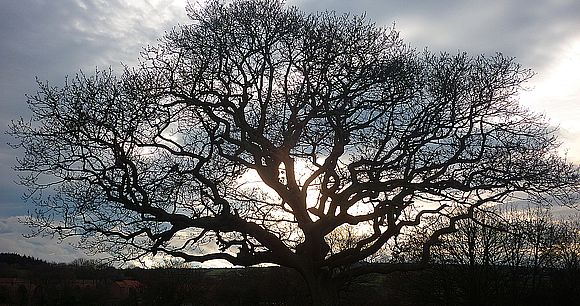
The Winter Solstice falls on December 22nd in the northern hemisphere this year, the date marking the Sun's lowest position in the sky. The tilt of the northern hemisphere away from the Sun has now reached its maximum and useful daylight is at a minimum, barely 7 ½ hrs from the latitude of Whitby - the shortest day, the Sun appearing just over 12 degrees above S horizon at local noon. Latest sunrise and earliest sunset however do not occur on this date. The Sun rises latest around Dec 28th but sets earliest mid-month. Astronomical winter commences for the Northern Hemisphere, but conversely days will slowly start to lengthen again. Cause for a celebration?
The significance of the Winter Solstice to our ancestors was probably due to the fact it did mark the start of the lengthening of days, a cause for ritual celebrations associated in their eyes with the death and rebirth of the Sun.
There are many Winter Solstice festivals and celebrations in the northern hemisphere. The celebration we enjoy - or endure, the Christian celebration of Christmas did not become a major festival until the 9th century, although the date of December 25 was pioneered by the Roman Emperor Constantine as far back as 336 A.D, perhaps to weaken established pagan celebrations that occurred around the Winter Solstice, remnants of which remain. Happy Winter Solstice everyone!
December Night Sky
Having not long completed our tour of seasonal autumnal constellations, celestial winter is about to take centre stage, however before our undivided attention is focused on this brilliant ensemble of stellar jewels, let us look at the bigger celestial picture. Starting in the North, where most of the circumpolar groups – those that do not set from our latitude, are located. Included amongst these are the two bears: Ursa Major and Minor. The Plough, the familiar ‘saucepan’ asterism, which is part of Ursa Major, prowls above N horizon. Directly above the Plough sits Ursa Minor in which the Pole star, Polaris resides (use the pointer stars in the bowl of the Plough - Dubhe and Merak to locate it). The Celestial dragon – Draco winds its way between the bears towards the NNW where the head of the beast is marked by an irregular quadrilateral of stars. At the same altitude a little further west of this asterism, the sparkling steely blue lustre of Vega catches the eye. Vega is the most conspicuous of the summer triangle stars in Lyra, whilst the stars of Cygnus, hang, crucifix form below its chief star Deneb above the WNW horizon. Just above the west horizon before 21:00hrs you may catch sight of Altair in Aquila the Eagle, the only member of the summer triangle to depart our skies.
Throughout the early part of the evening the zenith, the location directly overhead is occupied in turn by the distinctive ‘W’ pattern of Queen Cassiopeia, then Perseus - the outline of which resemble a distorted figure Pi symbol, and later in the evening the stars of Auriga the charioteer, highlighted by brilliant Capella.
Initially, the great square of Pegasus occupies the higher region due south below which reside the less conspicuous constellations of Pisces and Aquarius. Cetus the whale churns along the South horizon below Pisces; use the front two stars in the square to locate the 'Krakens' brightest star Diphda. The most famed object in Cetus is the variable star omicron ceti - otherwise known as Mira the wonderful, an extraordinary pulsating red super giant up to 300 million miles in diameter. Capricornus occupies the SSW horizon, departing early evening skies by mid-month. Try to spot conspicuous Fomalhaut in Pisces Austrinus, visible just above the SW horizon during early/mid evening until around 20:00hrs. It is the most southerly of first magnitude stars to rise over UK mainland shores. Scheat and Markab in the square of Pegasus point down to it during the first week in December.
By mid-December it is the southern half of the night sky which rightly gains the plaudits, one of nature’s finest free vistas. In this direction an observer is treated to an array of brilliant stars and imposing constellations, rich in mythology and observational interest, whether using binoculars, a telescope or just the naked eye. Located at the heart of this glittering tableau stands the mighty hunter, Orion, the main outline is quite distinct, three stars in a sloping line set amid a larger rectangle bounded by 4 others. Two of these stars, in opposing corners are super luminaries. Searing blue/white Rigel illuminates the bottom right of the rectangle, a star of spectral class B7 that is perhaps 60 – 75,000 times more luminous than our Sun, whilst the top left corner is occupied by Betelgeuse, a red super-giant star of deep orange hue, a clear indication of its age and cooler temperature. Rigel is massive enough to end its days as a supernova, tens of millions of years in the future, short enough by stellar standards, however of all the naked eye stars visible in the night sky, Betelgeuse is probably the strongest candidate to go supernova first, perhaps in less than 10-20 thousand years. Betelgeuse has already ballooned to gargantuan proportions, over 400 million miles in diameter. Put another way, if Betelgeuse were at the heart of our solar system, it would extend out beyond the orbit of Mars.
Situated beneath the three stars marking Orion’s belt is one of the heavens great show piece objects. Seen clearly as a misty smudge through binoculars, the Orion nebula is the nearest region of stellar birth around 1250 light years distant. The Nebula consists of a huge cloud of gas and dust in which new stars are “born”. Telescopically the nebula is quite breathtaking, a swirl of nebulous cloud at the heart of which reside the Trapezium stars, the four “bully boys” of this stellar crèche, little more than 10 million years old. Bearing down on Orion's right shoulder is Taurus the Bull (part of which adjoins Auriga above).
Taurus is home to the open star clusters, the Pleiades, and the Hyades. Prominent ruddy Aldebaran - “the eye of the bull’ is the most conspicuous presence in the Hyades, a ‘V’ or arrowhead arrangement of stars, though it is not a genuine member, lying at half the distance of true members. Brilliant Mars currently resides in Taurus to the left of Aldebaran and is of a similar hue. A little further west, upper right of the Hyades, the Pleiades star cluster (Seven Sisters) is truly a beautiful sight in binoculars or low power eyepiece, and one of the most youthful clusters by stellar standards. Keen sighted observers can make out more than seven stars with the naked eye, although most people see five or six. Binoculars, or very low telescopic magnifications reveal dozens, and the entire cluster contains over 300 members approximately 400 light years away.
Upper left of Orion stand the Twins of Gemini, marked by the two conspicuous stars, Castor, and Pollux. Castor, the most northerly of the pair, is slightly fainter than twin brother Pollux which shines with a pale amber lustre. Although Castor appears solitary, it is a multiple system of which the brightest two components may be separated in a modest scope, given stable atmospheric conditions.
As we head through December the two hunting dogs of Orion which accompany the hunter, Canis Major and Canis Minor, dutifully following their master across the heavens. The belt stars point down in the general direction of the most prominent of all night stars, sparkling Sirius, the Dog star in Canis Major seen low to the SE. Some distance above and left, solitary Procyon, in the lesser dog of Canis Minor, is yet another highly conspicuous winter jewel, the prominence of both stars primarily due to proximity; 8.6 and 11 light years respectively. The dog’s quarry, the timid celestial hare of Lepus, may be traced crouching below Orion and above the southern horizon. Look for the faint glow of the winter Milky Way which passes down to the left of Orion, separating the two dogs on opposing banks.
Finally, although astronomical winter may have just commenced, the first celestial shoots of Spring are already sprouting from the eastern horizon - late evening. The faint stars of Cancer lead the way, which scuttle after Gemini. Leo the lion follows, best identified by the ‘Sickle’ asterism at the foot of which shines bright Regulus. The faint, but distinctive head of Hydra sits below Procyon, the rest of the snake gradually slithering above the horizon, but not until the early hours of the morning!
No matter whether you are an experienced observer, or perhaps have just acquired a pair of binoculars or a telescope, the jewels of Orion and his retinue are a joy to explore time and time again. Wrap up warm, find somewhere dark and enjoy!
December Sky Charts
Additional Image Credits:
- Planets and Comets where not otherwise mentioned: NASA
- Sky Charts: Stellarium Software and Starry Night Pro Plus 8
- Log in to post comments

